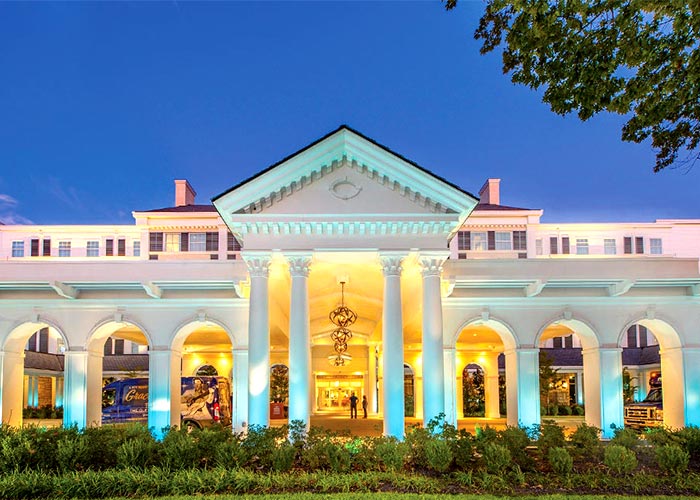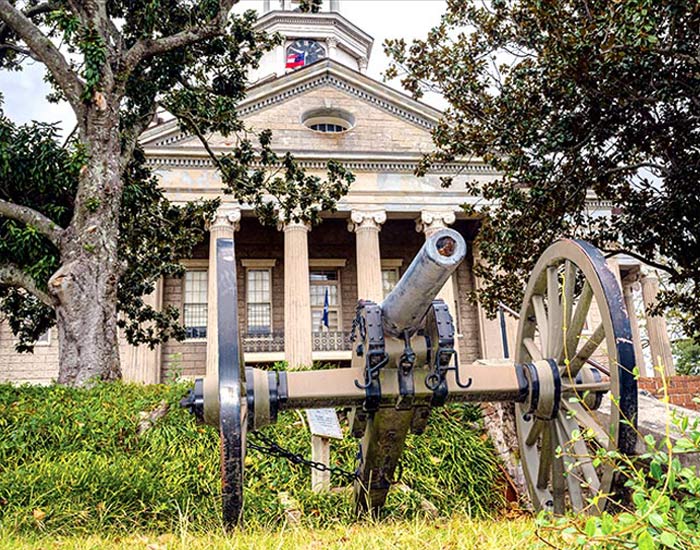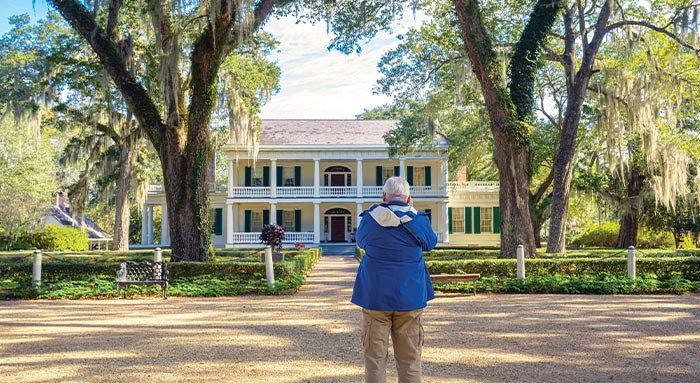On a brand-new small ship, the American Serenade, this Mississippi River cruise went from Memphis to New Orleans, with various stops along the way. We chose this trip because we enjoy the convenience of river cruising, and we had not previously visited this part of the country. It’s interesting to see how some folks in the “Mid-South” have survived environmental and historical challenges, changing with the times while acknowledging the good and bad of the past. You may gather from the length of this time that we thoroughly enjoyed this trip. You would be right!

Pre-Cruise Package
We opted for a pre-cruise package in Memphis. Having never been to this city before, we wanted to experience Sun Studio, Graceland, the Peabody Hotel ducks, Beale Street, and authentic Memphis barbeque.
Included in the pre-cruise package, the “VIP tour” in Graceland entitled us to a visit to the archives where we were allowed to hold (while wearing white gloves) a pair of black boots he wore while performing. Across the street from Graceland is a series of exhibits, including a collection of his various automobiles, airplanes, and other items.
We also visited the iconic Sun Studio where, in 1953, eighteen-year-old Elvis cut his first record. In a broader context, this is generally regarded as the birthplace of rock and roll. The tiny studio is much the same today as it was in the 1950s. The recording equipment, rudimentary by today’s standards, is still there.
The Cruise Begins
The Mississippi River is 640 miles of river from Memphis to New Orleans.
At some points, the river is so wide that it looks more like a lake. I am fascinated by its meandering, serpentine course which changes from time to time. Thus, some state boundaries established years ago now include portions of land across the present course of the river. In 1863, the port at Vicksburg was on the Mississippi. But the river moved to the west, and now the Vicksburg port is on the Yazoo River, a tributary of the Mississippi.
On the first part of our cruise, we saw little development along the shore. A guide explained that most of the area is agricultural, behind the tree line of the riverbanks. There wasn’t much traffic on the segment from Memphis to Vicksburg. Further south, there were long barges pushed by tugboats.

Vicksburg National Military Park
This town is famous for a pivotal Civil War engagement, the Siege of Vicksburg, which lasted for 47 days in 1863. Union General Ulysses Grant’s 45,000-men army outlasted the townspeople and troops of Confederate General John Pemberton. The besieged town surrendered on July 4, and it is said that this city declined to celebrate that national holiday for years thereafter. The Vicksburg National Military Park encompasses a large part of the siege and defense lines.
Confederate and Union forces faced off against each other along a narrow ridge outside of the city, a forecast of the trench warfare of World War I. Several midwestern Union states sent units to the battle; the Confederate troops were from Tennessee, Louisiana, and Mississippi. After the park was established in 1899, these states erected imposing monuments along the battle lines where their troops had been deployed. Kentucky, which had units for both sides, built two! Particularly impressive is the Illinois Monument, a large circular building. On the interior walls are plaques with the names of each participating unit, including a list of the unit’s officers, staff, and enlisted men! I did not imagine that record keeping was so careful and thorough in those times.
Farming
Agriculture dominates those areas of Mississippi and Louisiana along the river. The fertility of the land is attributable to those very floods previously mentioned. The flooding river brings with it rich soil which is deposited on the land as the waters recede. Paradoxically, those same floods that cause so much damage are essential for renewing the fertility of the soil. Our cruise offered excursions to two large farms, each family-owned and operated.
Four Oaks Farm
The next day, with the boat docked at St. Francisville, Louisiana, we took the “Southern Agriculture” excursion to Four Oaks Farm near Morganza. Two brothers and their families have mastered an unusual crop rotation: rice and crawfish. They plant rice; the growing rice plants provide coverage for crawfish; the rice is harvested; the fields are flooded; the crawfish are harvested; then they drain the fields, plant the rice, and start all over again.
We took a bus ride to a huge acreage of flooded fields, situated between levees and the river, and saw crawfish harvesting up close and personal. A small skiff motors into the water. The driver pulls up a trap, empties the crawfish into a bucket, replaces the trap in the water, and pulls up the next one, all while the boat is in motion. I along with a few other tourists enjoyed a brief ride in the boat.
When we returned to farm headquarters, a large table was laid out with freshly boiled crawfish, and we were invited to join in. The guide tried to teach us how to separate the meat from the shell, but I couldn’t catch on. Not to worry. The guide, next to me at the table, shucked them out as fast as I could eat them. Tasty!

Historic Homes
Needless to say, this itinerary provides tours to a seemingly unlimited supply of antebellum mansions: The Duff Green Mansion in Vicksburg, The Longwood (“the only octagonal mansion in the South”), and Dunleith Mansion in Natchez, Oakley House in St. Francisville and Houmas House & Gardens near Baton Rouge. All featured guided tours by knowledgeable docents, and some offered liquid refreshments. The common theme: all were built, typically with slave labor, prior to the Civil War; the owners lost everything in the war, and without slave labor, the houses fell into disrepair; they went through a series of unsuccessful owners; finally some foundation rescued them and restored them to their former glory. They now thrive as tourist attractions.
Cajun Country
In the late 17th century, French colonists in Canada were expelled from Acadia during the period leading up to the French and Indian War. These exiles settled in southern Louisiana. Over time they mixed with Native Americans, Africans, Irish, and Spanish settlers, creating their own unique culture. The former Acadians became the Cajuns, famous for their cuisine, music, and way of life. Laissez les bons rouler! Our guide on the “Cajun Pride Swamp Adventure” excursion, a modern woman proud of her Cajun heritage, discussed this on the bus ride. She entertained us with snippets of “Louisiana French,” the Cajun language.
The highlight of this trip was a boat ride on a bayou where we got up close and personal with alligators, wild hogs, raccoons and egrets. The Cajun captain enticed gators to the boat’s edge by offering them—wait for it—marshmallows! I wouldn’t think these sweets would be good for the gators’ health, but they swarmed about the boat and leaped to snare a marshmallow held on the end of a stick. There was a small captive alligator on board, said to be two years old, and we passed it around for obligatory photos. Boudreaux and Thibodeaux are fictional characters who are part of Southern Louisiana's oral tradition. The guides in this area entertained us with their stories. They are told with an exaggerated accent and don’t translate well to the written page.
Onboard Enrichment
Evening entertainment in the lounge was coordinated with our location on the river. In Memphis, there was an Elvis impersonator. In Cajun Country, two men played Zydeco (Cajun) music. In New Orleans, a husband and wife team from Preservation Hall played the music of Louis Armstrong and other jazz favorites. There was also a “resident entertainer,” a remarkable pianist who played classical and pop songs, all by ear, no sheet music. Also present throughout the trip was a guest speaker who gave talks on the geological history of the river, river commerce past and present, Creole origins, and native flora and fauna. This delightful lady joined us on several excursions.
If you would like to share your travel experiences with American Cruise Lines on our Blog, American Current, contact us at: marketing@americancruiselines.com


